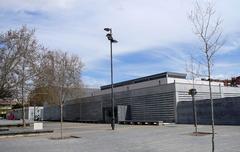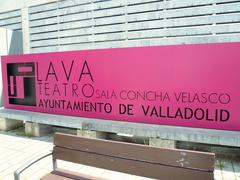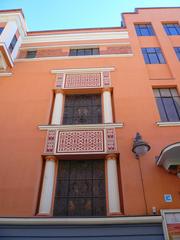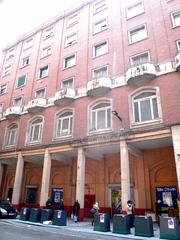Estadio Nuevo José Zorrilla: Comprehensive Visitor Guide to Tickets, Hours, and Valladolid’s Historical Heritage
Date: 03/07/2025
Introduction
Estadio Nuevo José Zorrilla is not just the home of Real Valladolid—it is a vibrant symbol of the city’s sporting passion, cultural pride, and architectural evolution. Since opening for the 1982 FIFA World Cup, the stadium has become a modern centerpiece for football, rugby, concerts, and community events, all while honoring the legacy of Valladolid’s celebrated poet José Zorrilla. Whether you are a football fan, a history enthusiast, or a traveler seeking local culture, this guide provides a detailed overview of visiting hours, ticketing, access, and tips for enjoying this iconic venue and nearby historical sites. (Wikipedia; Estadio Deportivo)
Table of Contents
- Origins and Historical Development
- The Significance of the Name “José Zorrilla”
- Visiting Estadio Nuevo José Zorrilla: Essential Information
- Stadium Design, Renovations, and Spectator Experience
- Getting There: Transport and Accessibility
- Ticketing and Entry
- Events, Atmosphere, and Unique Experiences
- Nearby Attractions and Cultural Highlights
- Frequently Asked Questions (FAQ)
- Conclusion and Final Tips
- References
Origins and Historical Development
The Estadio Nuevo José Zorrilla replaced the original stadium of the same name to meet the demands of the 1982 FIFA World Cup. Inaugurated on February 20, 1982, its first match saw Real Valladolid defeat Athletic Bilbao 1–0—a landmark event marking a new era for the club and the city. The stadium was strategically built on the west bank of the Pisuerga River, offering ample space for future expansion and modern amenities. Over time, the venue has evolved to accommodate larger crowds, improve safety, and offer a first-class experience for fans and event-goers. Key expansions include enclosing the upper tier (1986), seat upgrades to a purple-and-white mosaic (2012–13), and the removal of the dry moat to bring spectators closer to the action. Today, the stadium holds over 26,000 spectators and continues to host pivotal sporting and cultural events. (Wikipedia; FIFAUTeam)
The Significance of the Name “José Zorrilla”
The stadium pays homage to José Zorrilla y Moral (1817–1893), Valladolid’s renowned poet and playwright. Zorrilla’s cultural legacy is interwoven with the city, from the original “Campo de Zorrilla” to the current stadium. Naming the new venue “Nuevo José Zorrilla” perpetuates this tribute, merging the city’s literary pride with its footballing tradition. Landmarks such as Casa de Zorrilla, Plaza Zorrilla, and a statue memorialize this connection, reinforcing the stadium’s dual identity as a monument to both athletic and cultural achievement. (OneFootball)
Visiting Estadio Nuevo José Zorrilla: Essential Information
Location
- Address: Avenida Mundial 82 s/n, Distrito 10 (Girón), 47014 Valladolid, Spain
- Proximity: Around 2–4 km from Valladolid’s city center, easily accessible by public transport, car, or taxi. (Trek Zone)
Visiting Hours
- Match Days: Gates open 90 minutes before kickoff.
- Guided Tours: Available on select non-match days, typically Tuesday to Sunday, 10:00 AM – 6:00 PM. Closed Mondays and on event days. Always verify hours and availability on the official website.
Tickets
- Purchase: Available online via the official Real Valladolid website, authorized vendors, or at the stadium box office (subject to availability).
- Pricing: Varies by event and seat location. Football matches range from €23 to €50; concert prices vary by artist and configuration.
- Guided Tours: Tours offer access to stands, pitchside, and club museum. Discounts often available for children, seniors, and groups. (Football Tripper; SeatPick)
Accessibility
- The stadium features accessible seating, entrances, elevators, and restrooms.
- Staff assistance is available for visitors with reduced mobility.
- Ample on-site parking, including accessible spaces.
Stadium Design, Renovations, and Spectator Experience
Architectural Evolution
- Original (1982): Bowl design with an initial capacity of 15,000.
- Expansions: Upper tier enclosed (1986); capacity peaked at 33,000, then adjusted for safety regulations.
- Modernization: All seats replaced with purple-and-white mosaic (2012–13); dry moat removed (2019); further rows added to increase capacity to 26,451.
Recent Facade Renovation
- 2024–2025: A €990,000 facelift funded by the CVC initiative saw the exterior painted in vibrant violet and black, featuring the club crest and founding year “1928,” with structural beams painted black for contrast. (StadiumDB; COPE; ElDesmarque)
Spectator Experience
- Seating: Numbered, color-coded in club colors; premium and VIP suites available.
- Sightlines: Excellent views from all stands; bowl shape brings fans close to the action.
- Facilities: Multiple concession stands, modern restrooms, and a large official club shop.
- Wi-Fi: Limited to VIP and press areas; mobile coverage is generally good.
Getting There: Transport and Accessibility
By Public Transport
- Bus:
- Line 8 (Plaza de España to Miguel Delibes Cultural Center, stops near stadium)
- Line 9 (Plaza Madrid/train station to Hernando de Acuña, 10-min walk)
- Special Event Service: Extra buses on matchdays (Stadium Guide)
- Taxi: Easily available citywide; direct drop-off at stadium entrance.
By Car
- Parking:
- Over 3,200 spaces available for standard vehicles and buses.
- Main access via Avenida Mundial 82, plus routes from Avenida Real Valladolid and Calle Padre José Acosta.
From the Airport
- Valladolid Airport (Villanubla): 11 km northwest; best reached by taxi or rental car.
Ticketing and Entry
- Online Purchase: Recommended for high-demand matches and events (Football Tripper)
- Box Office: Open in the week leading up to events and on matchday.
- Entry: Multiple clearly marked gates, with separate access for general, premium, and accessible seating.
- Security: Standard bag checks; prohibited items include large bags, bottles, umbrellas, and flares.
Events, Atmosphere, and Unique Experiences
Sporting Events
- Football: Home to Real Valladolid; electrifying matchday atmosphere with “blanquivioleta” fans.
- Rugby: Hosted record-breaking Copa del Rey de Rugby finals and national team matches.
- Other Sports: Versatile for athletics and community events.
Concerts and Cultural Events
- Notable Performances: Michael Jackson, The Rolling Stones, Bruce Springsteen, Depeche Mode.
- Macroevents: Large concerts and electronic music festivals, especially in summer (Wololo Sound).
Anecdotes
- Legendary 1982 World Cup moment: Kuwaiti official halted play during France–Kuwait match—a story still recounted today. (OneFootball)
Nearby Attractions and Cultural Highlights
- Museo de la Ciencia: Interactive science exhibits, 10-min walk.
- Monastery of Nuestra Señora del Prado: Historic religious site, easily reached by taxi or bus.
- Centro Cultural Miguel Delibes: Major arts and performance venue, close by.
- Plaza Mayor & City Center: Bustling hub with tapas bars, shops, and museums.
- National Sculpture Museum: Renowned art collection, a must-see for culture lovers.
Frequently Asked Questions (FAQ)
What are the stadium’s visiting hours?
Visiting hours depend on the event; generally, the stadium is open for guided tours Tuesday–Sunday, 10:00 AM – 6:00 PM, and matchday gates open 90 minutes before kickoff.
How do I buy tickets?
Purchase online via the official Real Valladolid website, authorized vendors, or box office (subject to availability).
Is the stadium accessible for visitors with disabilities?
Yes, it offers accessible seating, entrances, restrooms, and staff assistance.
Are there stadium tours?
Tours are available on select non-match days; check the club’s website for the latest offerings.
What nearby historical sites should I visit?
Museo de la Ciencia, Monastery of Nuestra Señora del Prado, Plaza Mayor, and the National Sculpture Museum are all within easy reach.
Conclusion and Final Tips
Estadio Nuevo José Zorrilla stands at the crossroads of Valladolid’s sporting, cultural, and architectural legacy. From its World Cup origins to modern renovations, the stadium offers visitors a unique blend of local heritage and contemporary excitement. Whether attending a Real Valladolid match, a major concert, or simply touring the grounds, plan ahead—purchase tickets online, check visiting hours, and consider combining your trip with city sightseeing. For real-time updates and exclusive content, download the Audiala app and stay connected with everything happening at Estadio Nuevo José Zorrilla.
References
- Wikipedia
- Estadio Deportivo
- Blanquivioletas
- StadiumDB
- COPE
- ElDesmarque
- Futbol-Pro
- Football Tripper
- Wololo Sound
- Trek Zone
- OneFootball
- SeatPick
- Stadium Guide
- Valladolid Adelante
- Stadium Seating Plan
- Real Valladolid Official
- Audiala




